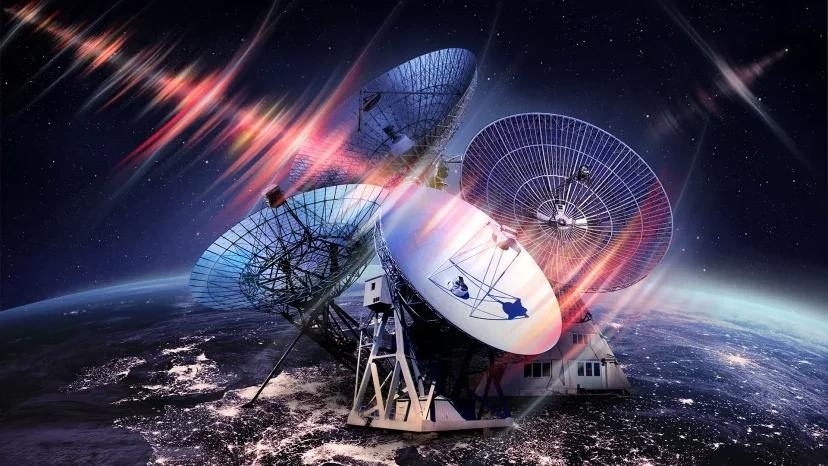Researchers under the direction of Franz Kirsten at Chalmers University of Technology have examined a well-known source of recurring rapid radio bursts, an as-yet-unexplained cosmic event. By comparing their findings with previous data, the scientists arrive at a conclusion that has broad implications: any source of rapid radio bursts will recur if it is observed closely and for an extended period of time.
 Four radio telescopes collected many bright fast radio bursts from one repeating source – many more than expected. Image Credit: Daniëlle Futselaar/artsource.nl
Four radio telescopes collected many bright fast radio bursts from one repeating source – many more than expected. Image Credit: Daniëlle Futselaar/artsource.nl
For more than fifteen years, astronomers have been fascinated by fast radio bursts. Radio telescopes located far across the cosmos are able to detect these fleeting, intense bursts of radio waves, which typically last only a few milliseconds.
In a recent investigation, researchers observed a recurring source of rapid radio bursts using radio telescopes located in Sweden, Germany, the Netherlands, and Poland. Utilizing four telescopes in northern Europe, the study team was a rare partnership of professional and amateur radio astronomers.
This is the longest study yet of a single source of fast radio bursts.
Wolfgang Herrmann, Amateur Radio Astronomer, Chalmers University of Technology
The four telescopes gazed at the source for up to twelve hours every day for several weeks.
Four telescopes participated in the observation campaign: the 32-meter telescope in Toruń, Poland; the 25-meter telescope in Stockert, Germany; the one-kilometer dish of the Westerbork Synthesis Radio Telescope in the Netherlands; and the 25-meter telescope in Onsala, Sweden.
The science team is made up of representatives from Astropeiler Stockert e.V., a non-profit organization that manages the Stockert telescope.
Over 46 brief bright bursts, each lasting a few milliseconds, were captured by the telescopes.
This source had been previously studied with a much bigger radio telescope, FAST in China, so we knew what to expect. But we were really surprised by what we saw. Of the bursts that we collected, far more than we expected of them were very bright ones.
Franz Kirsten, Astronomer at Onsala Space Observatory, Chalmers University of Technology
The astronomers argue that if this recurring source is common, they can come to two unexpected conclusions.
First, the new discoveries could suggest a startling new explanation about the causes of quick radio bursts.
Virtually every explosion that has been seen to date has only ever occurred once.
Since some sources repeat, it has been speculated that all of them could. Now finally, we have statistics on a repeater that allows us to make a proper comparison to non-repeaters. And it looks like that could really be true: all fast radio bursts will repeat if you look long enough.
Omar Ould-Boukattine, Astronomer, Astron and the University of Amsterdam
Secondly, the most luminous fast radio bursts might be observed across great distances.
Marcin Gawroński, team member at the Nicolaus Copernicus University in Toruń added, “We think bright bursts like these could be seen from the most distant galaxies known, like those discovered recently by the James Webb Space Telescope, which we see in light that has travelled to us since the universe was only a few hundred million years old.”
While the exact source of fast radio bursts is still unknown, several indications point to dense, magnetized relics of burst stars known as magnetars and neutron stars.
Kirsten added, “If we can see fast radio bursts from the time when the very first stars and galaxies were shining, that would give us a completely new way of accessing that time in the universe’s history.”
More About the Research
The findings of the study were published in the journal Nature Astronomy on January 4th, 2024.
Franz Kirsten (Onsala Space Observatory, Chalmers, Sweden), Omar S. Ould-Boukattine (ASTRON and University of Amsterdam, Netherlands), Wolfgang Herrmann (Astropeiler Stockert e.V.), Marcin P. Gawroński (Nicolaus Copernicus University, Toruń, Poland), Jason W. T. Hessels (University of Amsterdam, Netherlands), W. Lu (UC Berkeley, USA), Mark P. Snelders (University of Amsterdam, Netherlands), P. Chawla (University of Amsterdam, Netherlands), Jun Yang (Onsala Space Observatory, Chalmers, Sweden), R. Blaauw (ASTRON), Kenzie Nimmo (MIT, USA), W. Puchalska (Nicolaus Copernicus University, Toruń, Poland), P. Wolak (Nicolaus Copernicus University, Toruń, Poland), and R. van Ruiten (University of Amsterdam, Netherlands) constituted the science team.
The team’s source was found in the Taurus constellation on November 24th, 2020, by the CHIME telescope located in Canada. FRB 20201124A is the catalog number assigned to it. The source is part of a galaxy that is comparable in size to the Milky Way and is so far away that it took light from the galaxy 1.3 billion years to reach Earth.
Journal Reference:
Kirsten, F., et. al. (2023) A link between repeating and non-repeating fast radio bursts through their energy distributions. Nature Astronomy. doi:10.1038/s41550-023-02153-z